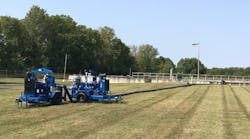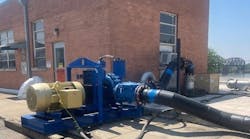Taos, a town in northern New Mexico with a population of 8,000, received an arsenic removal treatment system as part of the U.S. Environmental Protection Agency’s Arsenic Removal Demonstration Program in January 2005. The town had scheduled a new well, storage tank and booster pump system to be connected to the distribution system and put into service after the arsenic removal system was ready.
The Severn Trent SORB 33 arsenic removal system was selected for use at this demonstration site. Taos’ well number 8 system had an existing building to house the motor control center, chlorination unit and booster pumps. The well pump has a capacity of 480 gal per minute (gpm) and delivers water to a 50,000 gal tank on a hill above the building. There is also enough room in the building for the arsenic removal system. The well water has a slightly elevated arsenic level of 14 micrograms per liter (µg/L) and is low in total dissolved solids (TDS), but it has a very high pH of 9.5.
The system included 15 automatic valves, five for each adsorber. These are controlled by a PLC in the control panel with a touch-screen human machine interface. It is configured for parallel flow, and piping is schedule 80 PVC with PVC butterfly valves.
The system went into operation during February 2006.
The system was designed with pretreatment with pH reduction to lower the water’s alkalinity and improve the media arsenic adsorption performance. Carbon dioxide gas is injected into the water by downstream pH control. About 15 mg/L of CO 2 are added to lower the water’s pH to 7.4, an optimum level that allows maximum adsorption without a need for pH readjustment.
The gas is diffused into the water using a porous membrane housed in sidestream piping that feeds well water to the adsorbers. Complete gas dissolution occurs within 10 ft of piping. Carbon dioxide liquid is supplied in 480-lb dewars delivered weekly to the well house, and the arsenic system has an emergency backup unit with two 50 lb high-pressure CO 2 cylinders.
The dewars and cylinders are stored in a separate, ventilated room. The Taos adsorbers contain the new Bayoxide E33P media, a pelletized form of the granular product. The pellets have the same capacity but have a tighter size distribution (1 mm x 1.4 mm) that allows for lower pressure differential and less frequent backwashing in normal systems.


